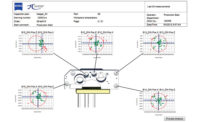HAMPTON, VA-Collier Research Corp., developer of HyperSizer structural sizing software, has joined with Simulia to release an interface between HyperSizer and Abaqus FEA that allows engineers to streamline the process of composite design optimization. The optimized design is reached through rapid iterations between HyperSizer and Abaqus.
Most recently, this solution was used on the design of NASA’s Ares V space launch vehicle, which makes significant use of composites. During flight, the shroud of the Ares V separates into four petals to release the lunar lander. In the design of this structure, the aerodynamic pressure on the shroud is resolved into internally distributed forces. Abaqus determines the load path/direction and how much load is in the stiffened panel and the ringframe. HyperSizer then analyzes or “sizes” the panels’ cross-sectional dimensions and layups to the Abaqus computed load, reducing structural weight, establishing margins of safety for all load cases and all potential failure modes and creating the stress report for aircraft airworthiness certification.
“Our partnership with Collier Research enables us to better serve the aerospace, energy and other industries that want to optimize their products earlier in the design phase,” says Tom Battisti, director of alliances, Simulia, Dassault Systèmes. “We continually strive to provide our customers with the tools they need to bring better products to market in less time and at lower cost. That’s exactly what the combination of Abaqus and HyperSizer enables them to do.”
HyperSizer software verifies structural integrity with the required calculations to predict all potential failure modes for all load cases and identify negative margins of safety. HyperSizer optimizes, or “sizes,” a design by surveying millions of candidate dimensions and laminates, finding optimum variables down to the ply level in a matter of minutes.
Abaqus analysis technology is used to perform implicit and explicit finite element analysis, including static, dynamic, impact and thermal analyses, all powered with robust contact and nonlinear material options. Optimization using Abaqus and HyperSizer follows an iterative process that begins with the transfer of data from Abaqus’ initial model to HyperSizer and continues until a convergence of internal load paths is reached, yielding a fully optimized structure. The Ares V’s payload shroud structure serves as an example of this optimization.
For more information, visitwww.hypersizer.comandwww.simulia.com.
Get our new eMagazine delivered to your inbox every month.
Stay in the know with Quality’s comprehensive coverage of the manufacturing and metrology industries.
SIGN UP TODAY!Copyright ©2024. All Rights Reserved BNP Media.
Design, CMS, Hosting & Web Development :: ePublishing


